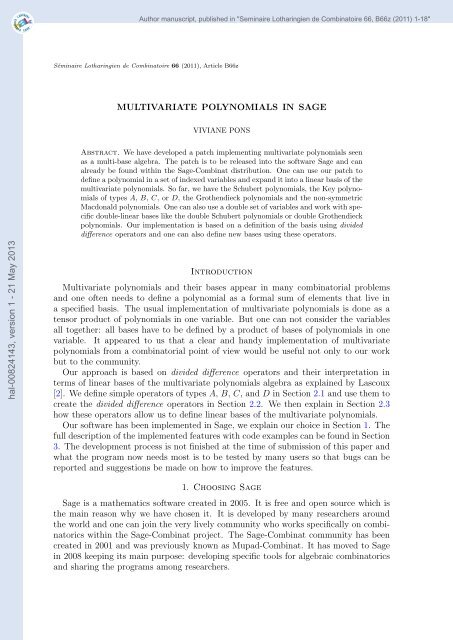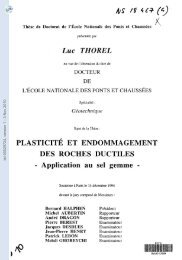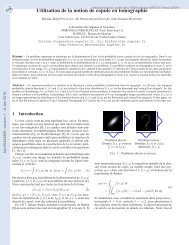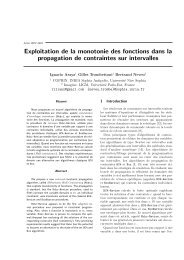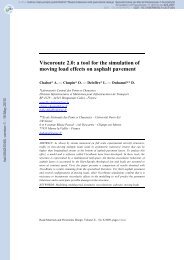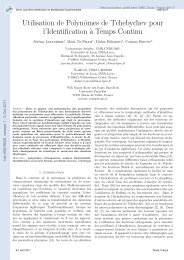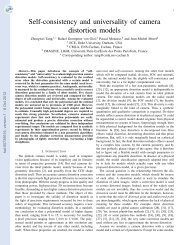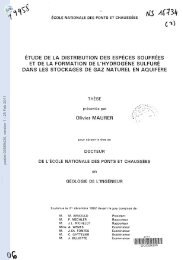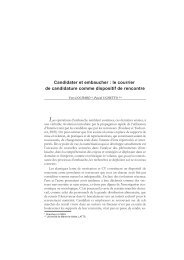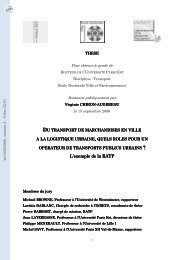MULTIVARIATE POLYNOMIALS IN SAGE
MULTIVARIATE POLYNOMIALS IN SAGE
MULTIVARIATE POLYNOMIALS IN SAGE
Create successful ePaper yourself
Turn your PDF publications into a flip-book with our unique Google optimized e-Paper software.
Author manuscript, published in "Seminaire Lotharingien de Combinatoire 66, B66z (2011) 1-18"<br />
Séminaire Lotharingien de Combinatoire 66 (2011), Article B66z<br />
<strong>MULTIVARIATE</strong> <strong>POLYNOMIALS</strong> <strong>IN</strong> <strong>SAGE</strong><br />
VIVIANE PONS<br />
Abstract. We have developed a patch implementing multivariate polynomials seen<br />
as a multi-base algebra. The patch is to be released into the software Sage and can<br />
already be found within the Sage-Combinat distribution. One can use our patch to<br />
define a polynomial in a set of indexed variables and expand it into a linear basis of the<br />
multivariate polynomials. So far, we have the Schubert polynomials, the Key polynomials<br />
of types A, B, C, or D, the Grothendieck polynomials and the non-symmetric<br />
Macdonald polynomials. One can also use a double set of variables and work with specific<br />
double-linear bases like the double Schubert polynomials or double Grothendieck<br />
polynomials. Our implementation is based on a definition of the basis using divided<br />
difference operators and one can also define new bases using these operators.<br />
hal-00824143, version 1 - 21 May 2013<br />
Introduction<br />
Multivariate polynomials and their bases appear in many combinatorial problems<br />
and one often needs to define a polynomial as a formal sum of elements that live in<br />
a specified basis. The usual implementation of multivariate polynomials is done as a<br />
tensor product of polynomials in one variable. But one can not consider the variables<br />
all together: all bases have to be defined by a product of bases of polynomials in one<br />
variable. It appeared to us that a clear and handy implementation of multivariate<br />
polynomials from a combinatorial point of view would be useful not only to our work<br />
but to the community.<br />
Our approach is based on divided difference operators and their interpretation in<br />
terms of linear bases of the multivariate polynomials algebra as explained by Lascoux<br />
[2]. We define simple operators of types A, B, C, and D in Section 2.1 and use them to<br />
create the divided difference operators in Section 2.2. We then explain in Section 2.3<br />
how these operators allow us to define linear bases of the multivariate polynomials.<br />
Our software has been implemented in Sage, we explain our choice in Section 1. The<br />
full description of the implemented features with code examples can be found in Section<br />
3. The development process is not finished at the time of submission of this paper and<br />
what the program now needs most is to be tested by many users so that bugs can be<br />
reported and suggestions be made on how to improve the features.<br />
1. Choosing Sage<br />
Sage is a mathematics software created in 2005. It is free and open source which is<br />
the main reason why we have chosen it. It is developed by many researchers around<br />
the world and one can join the very lively community who works specifically on combinatorics<br />
within the Sage-Combinat project. The Sage-Combinat community has been<br />
created in 2001 and was previously known as Mupad-Combinat. It has moved to Sage<br />
in 2008 keeping its main purpose: developing specific tools for algebraic combinatorics<br />
and sharing the programs among researchers.
2 VIVIANE PONS<br />
From the beginning, we wanted not only to develop in Sage but to be part of the<br />
main project by adding our implementation to the software. The program is still in<br />
test mode within the Sage-combinat distribution (see the installation process in Section<br />
3.1).<br />
Working in Sage also allowed us to use previous work and structures developed by the<br />
community. We worked a lot with Weyl Groups which had already been implemented<br />
in Sage. We also used the standard implementation of multi-base algebras as a base for<br />
our own work.<br />
And finally, we hope that being part of Sage will help our software to spread within<br />
the community and thus become useful to the largest possible community.<br />
hal-00824143, version 1 - 21 May 2013<br />
2. Multi-base polynomials<br />
2.1. Type A, B, C, D operators. At first, we need to define simple operations on<br />
vectors of integers. Let v ∈ Z n , we have the following operators corresponding to the<br />
root system of respective types A, B, C, D:<br />
vs i = (. . . , v i+1 , v i , . . .) for 1 ≤ i < n (1)<br />
vs B i = vs C i = (. . . , −v i , . . .) for 1 ≤ i ≤ n (2)<br />
vs D i = (. . . , −v i , −v i−1 , . . .) for 2 ≤ i ≤ n (3)<br />
The group generated by s 1 , . . . , s n−1 (respectively s 1 , . . . , s n−1 , s B n , and s 1 , . . . ,<br />
s n−1 , s D n ) is the Weyl group of type A (respectively B or C, D). The operators satisfy<br />
the braid relations:<br />
s i s i+1 s i = s i+1 s i s i+1 and s i s j = s j s i , |i − j| ≠ 1 (4)<br />
s n−1 s B n s n−1 s B n = s B n s n−1 s B n s n−1 and s i s B n = s B n s i , i ≤ n − 2 (5)<br />
s n−2 s D n s n−2 = s D n s n−2 s D n and s i s D n = s D n s i , i ≠ n − 2 (6)<br />
The orbit of the vector [1, 2, . . . , n] consists of all permutations of 1, 2, . . . , n, i.e., S n ,<br />
for type A, all signed permutations for type B, C, and all signed permutations with<br />
an even number of minus signs for type D. The elements of the different groups can<br />
be denoted by these objects. In the same way, elements of these groups can be seen<br />
as a product of operators s i , called a decomposition. When the product is of minimal<br />
length, it is called a reduced decomposition.<br />
2.2. Action on polynomials. We now have a natural action of the Weyl groups on<br />
polynomials. Indeed, let x = (x 1 , x 2 , . . . , x n ) be a set of variables and for v ∈ Z n , let x v<br />
stand for the monomial<br />
x v 1<br />
1 x v 2<br />
2 . . . x vn<br />
n . (7)<br />
A polynomial in the variables x 1 , . . . , x n can therefore be seen as a formal sum of vectors<br />
and the action of the operator s i becomes an action on polynomials:<br />
x v s i = x vs i<br />
. (8)
MULTIVARIABLE <strong>POLYNOMIALS</strong> <strong>IN</strong> <strong>SAGE</strong> 3<br />
From these simple operators s i , we can now define the divided difference operators. For<br />
type A, we have:<br />
f∂ i :=<br />
f − f s i<br />
x i − x i+1<br />
(9)<br />
fπ i := x if − x i+1 f s i<br />
x i − x i+1<br />
= f.(x i ∂ i ) (10)<br />
f ˆπ i := (f − f s i<br />
)x i+1<br />
= f.(π i − 1)<br />
x i − x i+1<br />
(11)<br />
fT i := f.(π i (t 1 + t 2 ) − s i t 2 ) (12)<br />
hal-00824143, version 1 - 21 May 2013<br />
for 1 ≤ i ≤ n − 1. ∂ i is the Newton divided difference, π i and ˆπ i are the isobaric divided<br />
differences and T i is the generator of the Hecke algebra H 2 . As the s i satisfy the braid<br />
relations, all the above operators do.<br />
If v i > v i+1 , the Newton divided difference ∂ i can be seen as an operator decrementing<br />
the vector degree and summing over all the intermediate monomials between<br />
x (...,v i−1,v i+1 ,...) and x (...,v i+1,v i −1,...) . For example,<br />
x (4,1) ∂ 1 = x (3,1) + x (2,2) + x (1,3) . (13)<br />
When v i < v i+1 , one just needs to switch v i and v i+1 , multiply by −1 and do the previous<br />
operation. When v i = v i+1 , the result is 0. This description can be used to give a more<br />
general, type-free definition. We can see the vectors indexing the monomials as elements<br />
of the ambient space of the root system of type A n−1 . The above ∂ i operation can then<br />
be seen as a formal sum of vectors, adding factors of the simple root (. . . , −1, 1 . . .) to<br />
the original vector. The sign of v i − v i+1 is given by the scalar product between the<br />
vector and the i th simple coroot of the ambient space. This definition is equivalent to<br />
the previous one. We can use it to define our divided differences in types B, C, and<br />
D, using the root systems of respective types B n , C n , and D n . Compared to type A,<br />
we add the n th simple root and coroot whose definition depends on the type and create<br />
the n th divided difference operator:<br />
∂n B = 1 − sB n<br />
x 1 2 n − x − 1 2<br />
n<br />
∂n C =<br />
1 − sC n<br />
x n − x −1<br />
n<br />
(14)<br />
(15)<br />
∂ D n = 1 − sD n<br />
x −1<br />
n−1 − x n<br />
(16)<br />
The same construction can be done with the isobaric divided differences π and ˆπ.<br />
2.3. Linear bases. We can now use these operators to define linear bases of the ring of<br />
multivariate polynomials. Let (x 1 , x 2 , . . . , x n ) and (y 1 , y 2 , . . . , y n ) be two sets of variables<br />
and λ a partition of length n, i.e., λ 1 ≥ λ 2 ≥ . . . ≥ λ n . We then define dominant
4 VIVIANE PONS<br />
hal-00824143, version 1 - 21 May 2013<br />
Schubert polynomials (respectively Grothendieck polynomials and Key polynomials) by<br />
n∏ ∏λ i<br />
Y λ := (x i − y j ), (17)<br />
G λ :=<br />
i=1 j=1<br />
n∏ ∏λ i<br />
(1 − y j x −1<br />
i ), (18)<br />
i=1 j=1<br />
K λ = ˆK λ := x λ . (19)<br />
We define Schubert polynomials to be all the non-zero images of the dominant Schubert<br />
polynomials under products of ∂ i and Grothendieck polynomials to be all the images of<br />
the dominant Grothendieck polynomials under products of π i . Similarly, the two types<br />
of Key polynomials are defined by taking all the images under products of π i or of ˆπ i<br />
respectively. Since the operators satisfy relations, we cannot index the polynomials by<br />
the choice of the starting point and the sequence of operators used. Rather, we use<br />
weight vectors v ∈ N n , the recursive definition being<br />
Y ...,vi+1 ,v i −1,... = Y v ∂ i (20)<br />
G ...,vi+1 ,v i −1,... = G v π i (21)<br />
K v π i = K vsi (22)<br />
ˆK vˆπ i = ˆK vsi , (23)<br />
the inal vectors v satisfying v i > v i+1 .<br />
As the operators satisfy braids relations, the order one chooses to apply the recursive<br />
rule on a vector does not change the result. There are dominant polynomials in the<br />
images of a dominant polynomial in the Schubert and Grothendieck case; therefore, one<br />
has to check consistency, but this is easy. These families constitute triangular bases of<br />
the polynomials in (x 1 , . . . , x n ). And one can easily express an arbitrary polynomial<br />
in these bases by inverting a triangular matrix. When working with a single set of<br />
variables, one can specialize the y i ’s to 0 (respectively to 1) and obtain simple Schubert<br />
polynomials (respectively Grothendieck polynomials), so that dominant polynomials<br />
become<br />
Y λ = x λ , (24)<br />
n∏<br />
G λ = (1 − x −1<br />
i ) λ i<br />
. (25)<br />
i=1<br />
To work with positive exponents on the Grothendieck basis, one can also set x i = 1−x −1<br />
i .<br />
Both versions of the bases are available in our implementation.<br />
Using the same method, we can also define non-symmetric Macdonald polynomials.<br />
In this case, there will be only one generator polynomial, i.e., M 0,0...,0 = 1, and we will<br />
use both the T i operator and a raising operator to increase the polynomial degree. The<br />
recursive rule is due to Sahi and Knop [1] and one can find its description in Lascoux<br />
[2].<br />
One can also define type B, C, and D Key polynomials using the operators defined<br />
from the Weyl group of the given types as explained in Section 2.2. The corresponding<br />
families of polynomials will then be indexed by vectors in Z n instead of N n and become
MULTIVARIABLE <strong>POLYNOMIALS</strong> <strong>IN</strong> <strong>SAGE</strong> 5<br />
bases of the Laurent polynomials of (x 1 , . . . , x n ), i.e., with both positive and negative<br />
exponents.<br />
hal-00824143, version 1 - 21 May 2013<br />
3. Software description<br />
3.1. Installation process. Our software has been developed as a part of the Sage<br />
project. Nevertheless, as it is still in test mode, at the publication time of this paper,<br />
it is not yet available on the main Sage distribution, but one can use it within the<br />
Sage-Combinat distribution.<br />
Step 1<br />
If Sage is not already installed on a computer, please follow the instructions on the<br />
Sage website [6] to get the installation process corresponding to your system.<br />
To get the latest version of our program, make sure you have the last version of Sage<br />
installed. You can upgrade your Sage version by running the following command inside<br />
your sage directory:<br />
./ sage - upgrade<br />
The examples below work with Sage 4.7 and later versions.<br />
Step 2<br />
Install Sage-Combinat [5] by running the following command inside the sage directory:<br />
./ sage - combinat install<br />
If you encounter problems, you find more information by visiting the Sage-Combinat<br />
website [5].<br />
3.2. Define a polynomial. Sage programming is object-oriented. The object containing<br />
the main software methods is called AbstractPolynomialRing. One first needs<br />
to create this object:<br />
sage : A = AbstractPolynomialRing (QQ)<br />
sage : A<br />
The abstract ring of multivariate polynomials on x over Rational<br />
Field<br />
Here, A represents the abstract algebra. To create an actual polynomial, we need a<br />
concrete basis.<br />
sage : m = A. monomial _ basis (); m<br />
The ring of multivariate polynomials on x over Rational Field on<br />
the monomial basis<br />
m is a concrete basis and we shall use it to create polynomials. Both of the syntaxes<br />
presented below can be used.<br />
sage : pol = m [1 ,1 ,2] + m [2 ,3]; pol<br />
x[1 , 1, 2] + x[2 , 3, 0]<br />
sage : pol = m ([1 ,1 ,2]) + m ([2 ,3]) ; pol<br />
x[1 , 1, 2] + x[2 , 3, 0]
6 VIVIANE PONS<br />
x[1, 1, 2] means x (1,1,2) = x 1 1x 1 2x 2 3. One does not have to declare beforehand how many<br />
variables are to be used, it will be computed from the size of the vectors. To know on<br />
how many variables a polynomial is defined, one can look at its parent. It can also be<br />
changed if needed.<br />
hal-00824143, version 1 - 21 May 2013<br />
sage : pol . parent ()<br />
The ring of multivariate polynomials on x over Rational Field<br />
with 3 variables on the monomial basis<br />
sage : pol = pol . change _nb_ variables (4)<br />
sage : pol<br />
x[1 , 1, 2, 0] + x[2 , 3, 0, 0]<br />
sage : pol . parent ()<br />
The ring of multivariate polynomials on x over Rational Field<br />
with 4 variables on the monomial basis<br />
Now we have a polynomial object to work with. A polynomial will always be seen<br />
as a formal sum of vectors: it cannot be factorized. If two polynomials are multiplied,<br />
the result will always be expanded as a sum.<br />
sage : pol * pol<br />
x[2 , 2, 4, 0] + 2*x[3 , 4, 2, 0] + x[4 , 6, 0, 0]<br />
3.3. Apply operators. We can now apply the divided differences operators defined in<br />
Section 2.2.<br />
sage : pol = m [1 ,1 ,2] + m [2 ,3]; pol<br />
x[1 , 1, 2] + x[2 , 3, 0]<br />
sage : pol . divided _ difference (2)<br />
-x[1 , 1, 1] + x[2 , 1, 1] + x[2 , 2, 0] + x[2 , 0, 2]<br />
sage : pol . divided _ difference _ isobar (2)<br />
x[2 , 1, 2] + x[2 , 2, 1] + x[2 , 3, 0] + x[2 , 0, 3]<br />
By default, the operator type is A, but we can also apply B, C, and D operators.<br />
sage : pol . divided _ difference (2 ,"B")<br />
x[1 , -1, 2] + x[1 , 0, 2] + x[2 , 0, 0] + x[2 , -3, 0] + x[2 , -2,<br />
0] + x[2 , -1, 0] + x[2 , 1, 0] + x[2 , 2, 0]<br />
sage : pol . divided _ difference (2 ,"C")<br />
x[1 , 0, 2] + x[2 , 0, 0] + x[2 , -2, 0] + x[2 , 2, 0]<br />
sage : pol . divided _ difference (2 ,"D")<br />
x[0 , 0, 0] + x[-2, -2, 0] + x[-1, -1, 0] + x[1 , 1, 0] + x[1 , 0,<br />
2] + x[2 , 2, 0] + x[0 , -1, 2]<br />
We have seen in Section 2.2 that type B, C, and D operators were defined from the<br />
root systems of types B n , C n , and D n , by the addition of the n th simple root and coroot.<br />
For each type, only one new operator was created which was the n th divided difference.<br />
But on the above example, applying the second divided difference on a polynomial in<br />
three variables gives a different result for types B, C, and D than for type A. Even<br />
though groups have been used to give a definition of our operators, we have extended
MULTIVARIABLE <strong>POLYNOMIALS</strong> <strong>IN</strong> <strong>SAGE</strong> 7<br />
it to obtain a definition only depending on the polynomial. From the root systems of<br />
type B n , C n , and D n , we had<br />
∂n B = 1 − sB n<br />
x 1 2 n − x − 1 2<br />
n<br />
∂n C =<br />
1 − sC n<br />
x n − x −1<br />
n<br />
(26)<br />
(27)<br />
So we just set<br />
∂ D n = 1 − sD n<br />
x −1<br />
n−1 − x n<br />
(28)<br />
∂ B i = 1 − sB i<br />
x 1 2<br />
i − x − 1 2<br />
i<br />
(29)<br />
hal-00824143, version 1 - 21 May 2013<br />
∂ C i = 1 − sC i<br />
x i − x −1<br />
i<br />
∂ D i = 1 − sD i<br />
x −1<br />
i−1 − x i<br />
with 1 ≤ i ≤ n for types B and C, and 2 ≤ i ≤ n for type D. These definitions allow<br />
us to study these operators for themselves and not relatively to their groups. As an<br />
example, this allows us to study the relations between ∂i<br />
B and ∂i+1. B It does not make<br />
sense from a group point of view but it remains an interesting question.<br />
Of course, one may want to use the group based operators only and not the generalized<br />
ones. This is possible by using a different basis. The basis we have been using so far is<br />
called the Monomial basis and is not related to any group. One can use a basis which<br />
is directly related to a root system called the Ambient space basis.<br />
sage : ma = A. ambient _ space _ basis ("A"); ma<br />
The ring of multivariate polynomials on x over Rational Field on<br />
the Ambient space basis of type A<br />
sage : pol = ma [1 ,1 ,2] + ma [2 ,3]<br />
sage : pol<br />
x(1 , 1, 2) + x(2 , 3, 0)<br />
sage : pol . parent ()<br />
The ring of multivariate polynomials on x over Rational Field<br />
with 3 variables on the Ambient space basis of type A<br />
sage : pol . divided _ difference (2)<br />
-x(1 , 1, 1) + x(2 , 1, 1) + x(2 , 2, 0) + x(2 , 0, 2)<br />
Note that Ambient Space basis is very close to the Monomial basis but the polynomial<br />
contains its type within its parent. It is related to a root system and only operators<br />
defined by this root system can be applied.<br />
sage : mb = A. ambient _ space _ basis ("B"); mb<br />
The ring of multivariate polynomials on x over Rational Field on<br />
the Ambient space basis of type B<br />
sage : pol = mb [1 ,1 ,2] + mb [2 ,3]<br />
(30)<br />
(31)
8 VIVIANE PONS<br />
hal-00824143, version 1 - 21 May 2013<br />
sage : pol . divided _ difference (2)<br />
-x(1 , 1, 1) + x(2 , 1, 1) + x(2 , 2, 0) + x(2 , 0, 2)<br />
sage : pol . divided _ difference (3)<br />
x(1 , 1, 0) + x(1 , 1, -2) + x(1 , 1, -1) + x(1 , 1, 1)<br />
Conversions between the Monomial basis and the Ambient space bases can be carried<br />
out easily:<br />
sage : pol = m [1 ,1 ,2] + m [2 ,3]; pol<br />
x[1 , 1, 2] + x[2 , 3, 0]<br />
sage : pol . parent ()<br />
The ring of multivariate polynomials on x over Rational Field<br />
with 3 variables on the monomial basis<br />
sage : pol = ma(pol ); pol<br />
x(1 , 1, 2) + x(2 , 3, 0)<br />
sage : pol . parent ()<br />
The ring of multivariate polynomials on x over Rational Field<br />
with 3 variables on the Ambient space basis of type A<br />
sage : pol = mb(pol ); pol<br />
x(1 , 1, 2) + x(2 , 3, 0)<br />
sage : pol . parent ()<br />
The ring of multivariate polynomials on x over Rational Field<br />
with 3 variables on the Ambient space basis of type B<br />
Even though the objects seem similar, one must always be careful with which basis one<br />
is working as it will impact the result of the operations as soon as operators are used.<br />
3.4. Working with multi-bases. We have already seen that our polynomials could<br />
be expressed on a different basis depending on which operations we wanted to make.<br />
But the Monomial basis as well as the Ambient space bases are just different versions<br />
of polynomials seen as sums of monomials. It is also possible to work with the linear<br />
bases we have defined in Section 2.3. Here is an example of the Schubert basis:<br />
sage : A = AbstractPolynomialRing (QQ)<br />
sage : Schub = A. schubert _ basis _on_ vectors ()<br />
sage : Schub<br />
The ring of multivariate polynomials on x over Rational Field on<br />
the Schubert basis of type A ( indexed by vectors )<br />
It can be used to create a Schubert polynomial and convert it to the monomial basis.<br />
sage : pol = Schub [1 ,2 ,2] + Schub [3 ,4]; pol<br />
Y(1 , 2, 2) + Y(3 , 4, 0)<br />
sage : pol . expand ()<br />
x(1 , 2, 2) + x(2 , 1, 2) + x(2 , 2, 1) + x(3 , 4, 0) + x(4 , 3, 0)<br />
sage : m( pol )<br />
x[1 , 2, 2] + x[2 , 1, 2] + x[2 , 2, 1] + x[3 , 4, 0] + x[4 , 3, 0]<br />
sage : Schub (m [1 ,2 ,4] + m [2 ,3])<br />
Y(1 , 2, 4) - Y(1 , 3, 3) - Y(1 , 4, 2) - Y(2 , 1, 4) + Y(2 , 3, 0) +<br />
Y(2 , 3, 2) + Y(2 , 4, 1) + Y(3 , 1, 3) - Y(3 , 2, 0) - Y(3 , 2,<br />
2) - Y(4 , 2, 1) + Y(5 , 1, 1)
MULTIVARIABLE <strong>POLYNOMIALS</strong> <strong>IN</strong> <strong>SAGE</strong> 9<br />
hal-00824143, version 1 - 21 May 2013<br />
One can multiply Schubert polynomials together and the result will be given in the<br />
same basis. However the program is converting the two polynomials into the monomial<br />
basis to multiply them and then convert the result back into the Schubert basis.<br />
sage : pol 1 = Schub [1 ,2 ,2] + Schub [3 ,4]<br />
sage : pol 2 = Schub [3 ,1 ,2]<br />
sage : pol 1 * pol 2<br />
Y(4 , 3, 4) + Y(5 , 2, 4) + Y(6 , 5, 2) + Y(6 , 6, 1) + Y(7 , 4, 2) +<br />
Y(7 , 5, 1)<br />
We have other bases implemented. Below is an example of the Key polynomials. One<br />
can convert directly from Schubert to Key polynomials without using the monomial<br />
basis manually (it is automatically done by the program):<br />
sage : K = A. demazure _ basis _on_ vectors ();K<br />
The ring of multivariate polynomials on x over Rational Field on<br />
the Demazure basis of type A ( indexed by vectors )<br />
sage : pol = K [2 ,1 ,4] + K [3 ,5 ,1]; pol<br />
K(2 , 1, 4) + K(3 , 5, 1)<br />
sage : pol . expand ()<br />
x(2 , 1, 4) + x(2 , 2, 3) + x(2 , 3, 2) + x(2 , 4, 1) + x(3 , 1, 3) +<br />
x(3 , 2, 2) + x(3 , 3, 1) + x(3 , 5, 1) + x(4 , 1, 2) + x(4 , 2,<br />
1) + x(4 , 4, 1) + x(5 , 3, 1)<br />
sage : Schub ( pol )<br />
Y(2 , 1, 4) + Y(3 , 5, 1) - Y(5 , 1, 1)<br />
sage : K(m [1 ,2 ,4] + m [2 ,3])<br />
K(1 , 2, 4) - K(1 , 3, 3) - K(1 , 4, 2) - K(2 , 1, 4) + K(2 , 3, 0) +<br />
K(2 , 3, 2) + K(2 , 4, 1) + K(3 , 1, 3) - K(3 , 2, 0) - K(3 , 2,<br />
2) + K(4 , 1, 2) - K(4 , 2, 1)<br />
sage : Khat = A. demazure _ hat _ basis _on_ vectors ()<br />
sage : pol = Khat [2 ,1 ,4] + Khat [3 ,5 ,1]; pol<br />
^K(2 , 1, 4) + ^K(3 , 5, 1)<br />
sage : pol . expand ()<br />
x(2 , 1, 4) + x(2 , 2, 3) + x(2 , 3, 2) + x(3 , 1, 3) + x(3 , 2, 2) +<br />
x(3 , 5, 1) + x(4 , 4, 1)<br />
sage : Schub ( pol )<br />
Y(2 , 1, 4) - Y(2 , 4, 1) + Y(3 , 5, 1) - Y(4 , 1, 2) + Y(4 , 2, 1) -<br />
Y(5 , 1, 1) - Y(5 , 3, 1)<br />
sage : Khat (m [1 ,2 ,4] + m [2 ,3])<br />
^K(1 , 2, 4) - ^K(1 , 3, 3) + ^K(2 , 3, 0) + ^K(2 , 3, 2)<br />
The key polynomials are also defined in type B, C, and D.<br />
sage : K = A. demazure _ basis _on_ vectors ("B");K<br />
The ring of multivariate polynomials on x over Rational Field on<br />
the Demazure basis of type B ( indexed by vectors )<br />
sage : pol = K[1 ,2 , -2]<br />
sage : pol<br />
K(1 , 2, -2)<br />
sage : pol . expand ()
10 VIVIANE PONS<br />
x(1 , 2, 0) + x(1 , 2, -2) + x(1 , 2, -1) + x(1 , 2, 1) + x(1 , 2, 2)<br />
+ x(2 , 1, 0) + x(2 , 1, -2) + x(2 , 1, -1) + x(2 , 1, 1) + x(2 ,<br />
1, 2) + x(2 , 2, 0) + x(2 , 2, -1) + x(2 , 2, 1)<br />
sage : pol = m[ -2 ,1 ,1] + m [1 , -1 ,1]; pol<br />
x[-2, 1, 1] + x[1 , -1, 1]<br />
sage : K( pol )<br />
K(0 , 0, 0) + K(-2, 1, 1) - K(-1, 1, 1) - K(-1, 1, 2) - K(-1, 0,<br />
1) - 2*K(1 , 0, 0) - K(1 , -2, 1) + K(1 , -1, 0) + 2*K(1 , -1, 1)<br />
+ K(1 , -1, 2) + K(1 , 1, 0) - K(1 , 1, -1) - 2*K(1 , 0, 1) + K<br />
(0 , 1, 1) + K(0 , 0, 1)<br />
Back in type A, we also have the simple Grothendieck basis. We have two versions<br />
of it related by a change of variable explained in Section 2.3 to avoid using negative<br />
exponents.<br />
hal-00824143, version 1 - 21 May 2013<br />
sage : Grothn = A. grothendieck _ negative _ basis _on_ vectors ();<br />
Grothn<br />
The ring of multivariate polynomials on x over Rational Field on<br />
the Grothendieck basis of type A with negative exponents (<br />
indexed by vectors )<br />
sage : pol = Grothn [1 ,2] + Grothn [2 ,2]; pol<br />
G(1 , 2) + G(2 , 2)<br />
sage : Grothp = A. grothendieck _ positive _ basis _on_ vectors ();<br />
Grothp<br />
The ring of multivariate polynomials on x over Rational Field on<br />
the Grothendieck basis of type A, with positive exponents (<br />
indexed by vectors )<br />
sage : pol . expand ()<br />
2*x(0 , 0) + x(-2, 0) - x(-2, -1) - 3*x(-1, 0) - x(-1, -2) + 4*x<br />
(-1, -1) + x(0 , -2) - 3*x(0 , -1)<br />
sage : pol = Grothp [1 ,2] + Grothp [2 ,2]; pol<br />
G(1 , 2) + G(2 , 2)<br />
sage : pol . expand ()<br />
x(1 , 2) + x(2 , 1)<br />
sage : pol . expand (). subs _ var ([(i ,1 -A. var (i) ^( -1) ) for i in xrange<br />
(1 ,3) ])<br />
2*x(0 , 0) + x(-2, 0) - x(-2, -1) - 3*x(-1, 0) - x(-1, -2) + 4*x<br />
(-1, -1) + x(0 , -2) - 3*x(0 , -1)<br />
The last basis we have implemented are the non-symmetric Macdonald polynomials.<br />
In order to use it, one has to define a polynomial ring on a bigger field than Q to use<br />
variables in the coefficients.<br />
sage : var (’t1 t2 q ’)<br />
(t1, t2, q)<br />
sage : K. = QQ []<br />
sage : K = K. fraction _ field ()<br />
sage : A = AbstractPolynomialRing (K);A
MULTIVARIABLE <strong>POLYNOMIALS</strong> <strong>IN</strong> <strong>SAGE</strong> 11<br />
The abstract ring of multivariate polynomials on x over Fraction<br />
Field of Multivariate Polynomial Ring in t1, t2, q over<br />
Rational Field<br />
sage : Mac = A. macdonald _ basis _on_ vectors ()<br />
sage : pol = Mac [1 ,2]; pol<br />
M(1 , 2)<br />
sage : pol . expand ()<br />
t 2^3* x(0 , 0) + t 2^2/ q*x(1 , 0) + ((t2*q+t2)/q ^2) *x(1 , 1) + 1/q^2*<br />
x(1 , 2) + ((t 2^2* q+t 2^2) /q)*x(0 , 1) + t2/q*x(0 , 2)<br />
sage : m = A. monomial _ basis ()<br />
sage : Mac ( m [1 ,1] )<br />
(-t1*t2)*M(0 , 0) + M(1 , 0) + q*M(1 , 1) + ((t1*t2*q^2+ t 2^2*q-t1*t<br />
2-t 2^2) /( -t1*q-t2))*M(0 , 1)<br />
hal-00824143, version 1 - 21 May 2013<br />
3.5. Define a new basis. All our bases are defined with divided differences acting<br />
recursively on sums of monomials. If one needs to work with a new basis where objects<br />
are indexed by vectors, the only thing to be implemented is the rule converting one<br />
vector to a sum of monomials. The inverse conversion is automatically done if the basis<br />
is triangular. One can define one’s own conversion function and so create a new basis.<br />
Below is an example to recreate the Schubert polynomials.<br />
sage : def schubert _on_ basis (v, basis , call _ back ):<br />
... for i in xrange ( len (v) -1):<br />
... if(v[i]
12 VIVIANE PONS<br />
hal-00824143, version 1 - 21 May 2013<br />
... return q *1/ t* call _ back (v). divided _ difference (i<br />
+1)<br />
... return basis (v)<br />
Now that we have the function, we will pass it to our algebra to create a new basis:<br />
sage : A = AbstractPolynomialRing (QQ)<br />
sage : myBasis = A. linear _ basis _on_ vectors ("A"," MySchub " ,"Y",<br />
schubert _on_ basis )<br />
sage : pol = myBasis [2 ,1 ,3]; pol<br />
Y(2 , 1, 3)<br />
sage : pol . expand ()<br />
x(2 , 1, 3) + x(2 , 2, 2) + x(2 , 3, 1) + x(3 , 1, 2) + x(3 , 2, 1) +<br />
x(4 , 1, 1)<br />
sage : myBasis (A.an_ element ())<br />
Y(1 , 2, 3) - Y(1 , 3, 2) - Y(2 , 1, 3) + Y(2 , 3, 1) + Y(3 , 1, 2) -<br />
Y(3 , 2, 1) + Y(4 , 1, 1)<br />
This is a copy of the Schubert basis, and it works the same way as the previous bases<br />
we have seen in Section 3.4. Below is an example with a parametrized function:<br />
sage : var (’q t ’)<br />
(q, t)<br />
sage : K. = QQ []<br />
sage : K = K. fraction _ field ()<br />
sage : A = AbstractPolynomialRing (K)<br />
sage : qtSchubertBasis = A. linear _ basis _on_ vectors ("A"," qtSchub<br />
" ," YQ",qt_ schubert _on_basis ,((" q",q) ,("t",t)) )<br />
sage : pol = qtSchubertBasis [1 ,2 ,3]; pol<br />
YQ (1 , 2, 3)<br />
sage : pol . expand ()<br />
q ^3/ t ^3* x(1 , 2, 3) + q ^3/ t ^3* x(1 , 3, 2) + q ^3/ t ^3* x(2 , 1, 3) +<br />
2*q^3/ t ^3* x(2 , 2, 2) + q ^3/ t ^3* x(2 , 3, 1) + q ^3/ t ^3* x(3 , 1,<br />
2) + q ^3/ t ^3* x(3 , 2, 1)<br />
The extra parameters are sent by a tuple of couples (parameter name, parameter value)<br />
to the main algebra that will create the new basis.<br />
3.6. Double set of variables. Our program also contains another algebra to work<br />
with a double set of variables.<br />
sage : D = DoubleAbstractPolynomialRing (QQ); D<br />
The abstract ring of multivariate polynomials on x over The<br />
abstract ring of multivariate polynomials on y over Rational<br />
Field<br />
One can see that the double algebra is the algebra of multivariate polynomials in the x<br />
variables with the multivariate polynomials in the y variables as coefficients.<br />
sage : D.an_ element ()<br />
y [0]* x[0 , 0, 0] + 2*y [0]* x[1 , 0, 0] + y [0]* x[1 , 2, 3] + 3*y [0]* x<br />
[2 , 0, 0]
MULTIVARIABLE <strong>POLYNOMIALS</strong> <strong>IN</strong> <strong>SAGE</strong> 13<br />
One can specify which bases to use in the x variables and which bases to use in the y<br />
variables.<br />
hal-00824143, version 1 - 21 May 2013<br />
sage : Dx = D<br />
sage : Dy = D. base _ ring ()<br />
sage : Schubx = Dx. schubert _ basis _on_ vectors ()<br />
sage : Schuby = Dy. schubert _ basis _on_ vectors ()<br />
sage : pol = Schuby [2 ,1 ,3] * Schubx [1 ,1 ,2]<br />
sage : pol<br />
(Yy (2 ,1 ,3) )*Yx (1 , 1, 2)<br />
The expand function or all direct conversions are done in the x variables.<br />
sage : pol . expand ()<br />
(Yy (2 ,1 ,3) )*x(1 , 1, 2) + (Yy (2 ,1 ,3) )*x(1 , 2, 1) + (Yy (2 ,1 ,3) )*x<br />
(2 , 1, 1)<br />
sage : mx = Dx. monomial _ basis ()<br />
sage : mx(pol )<br />
(Yy (2 ,1 ,3) )*x[1 , 1, 2] + (Yy (2 ,1 ,3) )*x[1 , 2, 1] + (Yy (2 ,1 ,3) )*x<br />
[2 , 1, 1]<br />
But, of course, one can also easily change the basis for the y variables.<br />
sage : my = Dy. monomial _ basis ()<br />
sage : pol . change _ coeffs _ bases (my)<br />
(y [2 ,1 ,3]+ y [2 ,2 ,2]+ y [2 ,3 ,1]+ y [3 ,1 ,2]+ y [3 ,2 ,1]+ y [4 ,1 ,1]) *Yx (1 , 1,<br />
2)<br />
sage : pol = mx(pol ); pol<br />
(Yy (2 ,1 ,3) )*x[1 , 1, 2] + (Yy (2 ,1 ,3) )*x[1 , 2, 1] + (Yy (2 ,1 ,3) )*x<br />
[2 , 1, 1]<br />
sage : pol . change _ coeffs _ bases (my)<br />
(y [2 ,1 ,3]+ y [2 ,2 ,2]+ y [2 ,3 ,1]+ y [3 ,1 ,2]+ y [3 ,2 ,1]+ y [4 ,1 ,1]) *x[1 , 1,<br />
2] + (y [2 ,1 ,3]+ y [2 ,2 ,2]+ y [2 ,3 ,1]+ y [3 ,1 ,2]+ y [3 ,2 ,1]+ y [4 ,1 ,1]) *<br />
x[1 , 2, 1] + (y [2 ,1 ,3]+ y [2 ,2 ,2]+ y [2 ,3 ,1]+ y [3 ,1 ,2]+ y [3 ,2 ,1]+ y<br />
[4 ,1 ,1]) *x[2 , 1, 1]<br />
One can also change the role of variables between the main ones and the coefficients.<br />
sage : pol<br />
(Yy (2 ,1 ,3) )*x[1 , 1, 2] + (Yy (2 ,1 ,3) )*x[1 , 2, 1] + (Yy (2 ,1 ,3) )*x<br />
[2 , 1, 1]<br />
sage : pol . swap _ coeffs _ elements ()<br />
(x [1 ,1 ,2]+ x [1 ,2 ,1]+ x [2 ,1 ,1]) *Yy (2 , 1, 3)<br />
So we have seen that we can use our previous bases on a double set of variables. But<br />
we also have specific bases that only work with a double set of variables. Let us see the<br />
double Schubert polynomials and double Grothendieck polynomials, the way they were<br />
defined in Section 2.3.<br />
sage : DoubleSchub = D. double _ schubert _ basis _on_ vectors ();<br />
DoubleSchub
14 VIVIANE PONS<br />
hal-00824143, version 1 - 21 May 2013<br />
The ring of multivariate polynomials on x over The abstract ring<br />
of multivariate polynomials on y over Rational Field on the<br />
Double Schubert basis of type A ( indexed by vectors )<br />
sage : pol = DoubleSchub [1 ,2]; pol<br />
y [0]* YY (1 , 2)<br />
sage : pol . expand ()<br />
(-y (2 ,1 ,0) -y (2 ,0 ,1) )*x(0 , 0) + (y (1 ,1 ,0) +y (1 ,0 ,1) +y (2 ,0 ,0) )*x(1 ,<br />
0) + ( -2*y(1 ,0 ,0) -y (0 ,1 ,0) -y (0 ,0 ,1) )*x(1 , 1) + y [0]* x(1 , 2)<br />
+ (-y [1]) *x(2 , 0) + y [0]* x(2 , 1) + (y (1 ,1 ,0) +y (1 ,0 ,1) +y<br />
(2 ,0 ,0) )*x(0 , 1) + (-y [1]) *x(0 , 2)<br />
sage : DGroth = D. double _ grothendieck _ basis _on_ vectors (); DGroth<br />
The ring of multivariate polynomials on x over The abstract ring<br />
of multivariate polynomials on y over Rational Field on the<br />
Double Grothendieck basis of type A ( indexed by vectors )<br />
sage : pol = DGroth [1 ,2]; pol<br />
y [0]* GG (1 , 2)<br />
sage : pol . expand ()<br />
y [0]* x(0 , 0) + (-y (2 ,1 ,1) )*x(-2, -2) + (y (1 ,1 ,1) )*x(-2, -1) + (-<br />
y [1]) *x(-1, 0) + (y (1 ,1 ,1) )*x(-1, -2) + (y (2 ,0 ,0) -y (0 ,1 ,1) )*x<br />
(-1, -1) + (-y [1]) *x(0 , -1)<br />
4. Some advanced applications<br />
4.1. Projective degrees of Schubert varieties. In his Ph.D. thesis, Veigneau [7]<br />
presents an application of the software ACE by computing the projective degree of<br />
Schubert varieties. We can implement this same function with our patch on Sage-<br />
Combinat. The projective degree d(X) of a sub-variety X ⊂ P M of codimension k is<br />
the number of intersections between X and a generic hyperplane of dimension k. For<br />
σ a permutation of size n and X σ a Schubert sub-variety of the flag variety F(C n )<br />
embedded in P M by the Plücker embedding (with M = 2 N − 1 where N = n(n−1) is<br />
2<br />
the dimension of F(C n )), d(X σ ) is a coefficient in a product in the Schubert basis.<br />
More precisely, the first Chern class of the tautologic invertible vectorial fiber of P M is<br />
h = (n − 1)x 1 + (n − 2)x 2 + . . . + x n−1 and d(X σ ) is the coefficient of Y n−1,n−2,...,0 in<br />
h N−l(σ) Y v , where Y v is the Schubert polynomial indexed by v, the Lehmer code of σ [3].<br />
The following function computes these degrees:<br />
def proj _ deg ( perm ):<br />
n = len ( perm )<br />
d = n*(n -1) /2 - perm . length ()<br />
# we create the polynomial ring and the bases<br />
A = AbstractPolynomialRing (QQ)<br />
Schub = A. schubert _ basis _on_ vectors ()<br />
# we compute the product<br />
h = sum ( [(n-i) * A. var (i) for i in xrange (1 ,n)])<br />
res = Schub ( h**d * Schub ( perm .to_ lehmer _ code ()))
MULTIVARIABLE <strong>POLYNOMIALS</strong> <strong>IN</strong> <strong>SAGE</strong> 15<br />
# we look for the right coefficient<br />
for (key , coeff ) in res :<br />
if ([ key [i] for i in xrange (n)] == [n-i for i in xrange<br />
(1 ,n +1) ]):<br />
return coeff<br />
hal-00824143, version 1 - 21 May 2013<br />
return 0<br />
One can also compute the product and directly read the result:<br />
sage : A = AbstractPolynomialRing (QQ)<br />
sage : m = A. monomial _ basis ()<br />
sage : Schub = A. schubert _ basis _on_ vectors ()<br />
sage : Schub ( (3* m [1] + 2*m[0 ,1] + m [0 ,0 ,1]) ^4 * Schub [1 ,0 ,1 ,0])<br />
8*Y(1 , 1, 4, 0) + 23* Y(1 , 2, 3, 0) + 24* Y(1 , 3, 2, 0) + 39* Y(1 ,<br />
4, 1, 0) + 15* Y(1 , 5, 0, 0) + Y(1 , 0, 5, 0) + 48* Y(2 , 1, 3,<br />
0) + 101* Y(2 , 2, 2, 0) + 117* Y(2 , 3, 1, 0) + 84* Y(2 , 4, 0, 0)<br />
+ 12* Y(2 , 0, 4, 0) + 173* Y(3 , 1, 2, 0) + 78* Y(3 , 2, 1, 0) +<br />
147* Y(3 , 3, 0, 0) + 53* Y(3 , 0, 3, 0) + 283* Y(4 , 1, 1, 0) +<br />
171* Y(4 , 2, 0, 0) + 96* Y(4 , 0, 2, 0) + 93* Y(5 , 1, 0, 0) +<br />
176* Y(5 , 0, 1, 0) + 80* Y(6 , 0, 0, 0)<br />
sage : proj _ deg ( Permutation ([2 ,1 ,4 ,3]) )<br />
78<br />
We can use our function to compute the degree for all permutations of size 4:<br />
sage : degrees = {}<br />
sage : for perm in Permutations (4) :<br />
....: degrees [ perm ] = proj _ deg ( perm )<br />
....:<br />
sage : degrees<br />
{[2 , 1, 4, 3]: 78 , [1 , 3, 4, 2]: 48 , [3 , 2, 4, 1]: 3, [3 , 1, 2,<br />
4]: 48 , [4 , 2, 1, 3]: 3, [1 , 4, 2, 3]: 46 , [3 , 2, 1, 4]: 16 ,<br />
[4 , 1, 3, 2]: 3, [2 , 3, 4, 1]: 6, [3 , 4, 2, 1]: 1, [1 , 2, 3,<br />
4]: 720 , [1 , 3, 2, 4]: 280 , [2 , 4, 3, 1]: 3, [2 , 3, 1, 4]:<br />
46 , [3 , 4, 1, 2]: 2, [4 , 2, 3, 1]: 1, [1 , 4, 3, 2]: 16 , [4 ,<br />
1, 2, 3]: 6, [2 , 4, 1, 3]: 12 , [4 , 3, 1, 2]: 1, [4 , 3, 2, 1]:<br />
1, [3 , 1, 4, 2]: 14 , [2 , 1, 3, 4]: 220 , [1 , 2, 4, 3]: 220}<br />
4.2. Determinants of Schur functions. Grassmannian Schubert polynomials are<br />
the Schubert polynomials indexed by vectors v such that v 1 ≤ v 2 ≤ . . . ≤ v n . They<br />
are symmetric functions in x 1 , . . . , x n . In a single set of variables (i.e., specializing y to<br />
0), Grassmannian Schubert polynomials are equal to Schur functions. More precisely,<br />
the transition matrix between double Grassmannian Schubert polynomials and Schur<br />
functions is unitriangular.<br />
sage : A = AbstractPolynomialRing (QQ)<br />
sage : Schub = A. schubert _ basis _on_ vectors ()<br />
sage : pol = Schub [1 ,2]
16 VIVIANE PONS<br />
hal-00824143, version 1 - 21 May 2013<br />
sage : pol . expand ()<br />
x(1 , 2) + x(2 , 1)<br />
sage :<br />
sage : D = DoubleAbstractPolynomialRing (QQ)<br />
sage : DSChub = D. double _ schubert _ basis _on_ vectors ()<br />
sage : pol = DSchub [1 ,2]<br />
sage : pol<br />
y [0]* YY (1 , 2)<br />
sage : Schub = D. schubert _ basis _on_ vectors ()<br />
sage : Schub ( pol )<br />
y [0]* Yx (1 , 2) + (-y (2 ,1 ,0) -y (2 ,0 ,1) )*Yx (0 , 0) + (-y (1 ,0 ,0) -y<br />
(0 ,1 ,0) -y (0 ,0 ,1) )*Yx (1 , 1) + (y (1 ,1 ,0) +y (1 ,0 ,1) +y (2 ,0 ,0) )*Yx<br />
(0 , 1) + (-y [1]) *Yx (0 , 2)<br />
This allows us to compute determinants of Schur functions by replacing these by Schubert<br />
polynomials and specializing arbitrarily the y variables. For example, we can<br />
compute<br />
|s µ (A)| µ⊆11 , (32)<br />
where A ∈ [{x 1 , x 2 }, {x 1 , x 3 }, {x 2 , x 3 }], and prove that it is equal to ∏ j>i (x j − x i ).<br />
First, we replace s µ by<br />
|Y u (A, y)| u=00,01,11 (33)<br />
and specialize y 1 = x 1 , y 2 = x 2 , in which case the determinant becomes<br />
1 1 1<br />
0 x 3 − x 2 x 3 − x 1<br />
∣ 0 0 (x 3 − x 1 )(x 2 − x 1 ) ∣<br />
and gives the result. The following function computes the above Matrix:<br />
def compute _ matrix ( variables , alphabet , indices ):<br />
n = len ( indices )<br />
(34)<br />
# Initial definitions<br />
K = PolynomialRing (QQ ,[ var (v) for v in variables ])<br />
K = K. fraction _ field ()<br />
D = DoubleAbstractPolynomialRing (K)<br />
DSchub = D. double _ schubert _ basis _on_ vectors ()<br />
result _ matrix = []<br />
for u in indices :<br />
line = []<br />
# the expansion on the double schubert will allow us to<br />
compute the result<br />
pu = DSchub (u). expand ()
MULTIVARIABLE <strong>POLYNOMIALS</strong> <strong>IN</strong> <strong>SAGE</strong> 17<br />
hal-00824143, version 1 - 21 May 2013<br />
In Sage:<br />
for a in alphabet :<br />
#we apply our polynomial on alphabets and<br />
specialize the y ( this should be improved on<br />
further versions )<br />
pol = pu. subs _ var ( [(i,K(a[i])) for i in xrange ( len (<br />
a))])<br />
pol = pol . swap _ coeffs _ elements ()<br />
pol = pol . subs _ var ( [(i,K( variables [i])) for i in<br />
xrange ( pol .nb_ variables ()) ] )<br />
if(pol ==0) :<br />
coeff = 0<br />
else :<br />
coeff = list ( list ( pol ) [0][1]) [0][1]<br />
line . append ( coeff )<br />
result _ matrix . append ( line )<br />
return Matrix (K, result _ matrix )<br />
sage : variables = ("x1" , "x2" , "x 3")<br />
sage : alphabet = [[" x1" ,"x2"] ,[" x1" ,"x3"] ,[" x2" ,"x 3"]]<br />
sage : indices = [[0 ,0] ,[0 ,1] ,[1 ,1]]<br />
sage :<br />
sage : res = compute _ matrix ( variables , alphabet , indices )<br />
sage : res<br />
[ 1 1 1 ]<br />
[ 0 -x2 + x3 -x1 + x3 ]<br />
[ 0 0 x 1^2 - x1*x2 - x1*x3 + x2*x3]<br />
sage : det = res . determinant ()<br />
sage : det<br />
-x 1^2* x2 + x1*x2^2 + x 1^2* x3 - x 2^2* x3 - x1*x3^2 + x2*x3^2<br />
sage : factor ( det )<br />
(x2 - x3) * (-x1 + x2) * (x1 - x3)<br />
References<br />
[1] F. Knop and S. Sahi. Difference equations and symmetric polynomials defined by their zeros.<br />
International Mathematics Research Notices, 1996(10):473–486, 1996.<br />
[2] A. Lascoux. Schubert and Macdonald polynomials, a parallel. Electronically available at http:<br />
//igm.univ-mlv.fr/%7Eal/ARTICLES/Dummies.pdf.<br />
[3] A. Lascoux. Classes de Chern des variétés de drapeaux. C. R. Acad. Sci. Paris Sér. I Math.,<br />
295(5):393–398, 1982.<br />
[4] I. G. Macdonald. Affine Hecke algebras and orthogonal polynomials. Astérisque No. 237, Exp.<br />
No. 797, 4, 189–207, 1996. Séminaire Bourbaki, Vol. 1994/95.<br />
[5] The Sage-Combinat community. Sage-Combinat: enhancing Sage as a toolbox for computer exploration<br />
in algebraic combinatorics, 2008. http://combinat.sagemath.org.<br />
[6] W. A. Stein et al. Sage Mathematics Software (Version 4.7). The Sage Development Team, 2011.<br />
http://www.sagemath.org.
18 VIVIANE PONS<br />
[7] S. Veigneau. Calcul symbolique et calcul distribué en combinatoire algébrique. PhD thesis, Université<br />
de Marne-la-Vallée, 1996.<br />
Institut Gaspard Monge, Université Paris-Est, Marne-la-Vallée, France<br />
hal-00824143, version 1 - 21 May 2013


